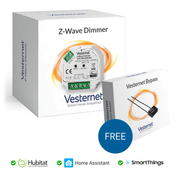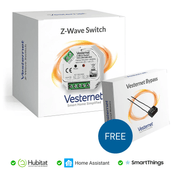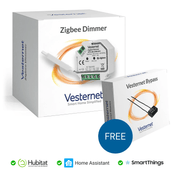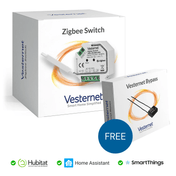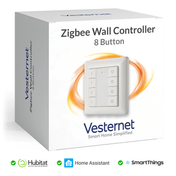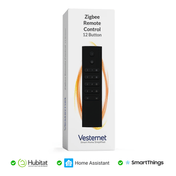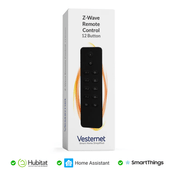The evolution from Zigbee 1.2 to Zigbee 3.0 represents one of the most significant advances in smart home wireless technology. Understanding these differences is crucial for building reliable, secure, and future-proof smart home systems. This comprehensive guide explains the technical improvements, compatibility considerations, and practical implications of choosing between these Zigbee versions.
1. Understanding Zigbee Protocol Evolution
Zigbee has undergone significant evolution since its inception, with each version addressing limitations and adding new capabilities. The progression from Zigbee 1.2 to Zigbee 3.0 represents over a decade of technological advancement and real-world learning from smart home deployments worldwide.
The Foundation: Zigbee Home Automation 1.2
When discussing "Zigbee 1.2," we're typically referring to the Zigbee Home Automation 1.2 profile, which was ratified in 2013 and became the standard for smart home devices. This built upon earlier Zigbee protocols dating back to 2007, establishing the application profile that made Zigbee popular for home automation.
Core Architecture: Zigbee 1.2 was built on the IEEE 802.15.4 standard, operating primarily in the 2.4GHz frequency band (with regional variants at 868MHz in Europe and 915MHz in North America). It introduced the concept of application profiles, which defined how different types of devices should communicate. The most common profiles included Home Automation (HA), Smart Energy (SE), and Building Automation (BA).
Network Topology: The protocol supported three types of devices: coordinators (network controllers), routers (range extenders), and end devices (sensors and actuators). This hierarchy enabled mesh networking, where messages could hop through multiple devices to reach their destination, providing resilience and extended range.
Security Model: Zigbee 1.2 implemented a basic security model with 128-bit AES encryption. However, the security implementation was relatively simple, with network keys often shared across all devices and limited protection against sophisticated attacks.
Interoperability Challenges: One of the significant limitations of Zigbee 1.2 was the fragmentation caused by different application profiles. Devices using different profiles often couldn't communicate directly, leading to compatibility issues and vendor lock-in situations. Even devices using the same profile from different manufacturers sometimes had interoperability issues.
The Revolution: Zigbee 3.0
Zigbee 3.0, introduced in 2016, represented a fundamental reimagining of the Zigbee protocol. Rather than being just another incremental update, Zigbee 3.0 unified the fragmented ecosystem and introduced modern security and interoperability standards. Importantly, Zigbee 3.0 also serves as a foundation technology for Matter (formerly Project CHIP), making it a key part of the evolving smart home ecosystem.
Unified Application Layer: The most significant change in Zigbee 3.0 was the unification of all previous application profiles into a single, comprehensive standard. This eliminated the compatibility issues that plagued earlier versions and ensured that all Zigbee 3.0 devices could communicate regardless of their specific function.
Enhanced Security: Zigbee 3.0 introduced a completely redesigned security model with multiple layers of protection. This includes improved key management, secure commissioning processes, and protection against various attack vectors that were possible with earlier versions.
Improved Commissioning: The device joining process was completely redesigned to be more secure and user-friendly. Zigbee 3.0 introduced standardised commissioning methods that work consistently across all devices and manufacturers.
Green Power Support: Zigbee 3.0 includes native support for Green Power devices, which are ultra-low-power devices that can operate without batteries by harvesting energy from their environment (such as kinetic energy from button presses or light from solar cells).
Future-Proofing: Zigbee 3.0 was designed with extensibility in mind, allowing for new device types and capabilities to be added without breaking compatibility with existing devices. This forward-thinking approach has positioned Zigbee 3.0 as a foundation technology for emerging standards like Matter.
2. Security Enhancements in Zigbee 3.0
Security represents one of the most significant improvements in Zigbee 3.0. The enhanced security model addresses vulnerabilities identified in earlier versions and provides protection against modern cyber threats.
Comprehensive Security Architecture
Zigbee 3.0 implements a multi-layered security approach that protects against various attack vectors and provides defense in depth.
Network Security: The network layer security in Zigbee 3.0 uses 128-bit AES encryption with improved key management. Unlike Zigbee 1.2, which often used a single network key for all communications, Zigbee 3.0 implements a more sophisticated key hierarchy that provides better isolation between different parts of the network.
Application Security: Zigbee 3.0 introduces application-level security that provides an additional layer of protection beyond network encryption. This includes application-specific keys and authentication mechanisms that prevent unauthorised access to device functions even if network security is compromised.
Link Security: Individual device-to-device communications can be protected with unique link keys, providing end-to-end encryption that prevents eavesdropping even by other devices on the same network.
Secure Commissioning Process
The device joining process in Zigbee 3.0 has been completely redesigned to eliminate security vulnerabilities present in earlier versions.
Install Codes: Zigbee 3.0 introduces the concept of install codes, which are unique cryptographic keys pre-installed on each device during manufacturing. These codes ensure that only authorised devices can join a network and prevent unauthorised devices from gaining access.
Secure Key Exchange: The key exchange process during device commissioning uses cryptographically secure methods to establish encryption keys. This prevents man-in-the-middle attacks and ensures that communication keys are not exposed during the joining process.
Certificate-Based Authentication: Zigbee 3.0 supports certificate-based authentication for high-security applications. This provides strong device identity verification and prevents device spoofing attacks.
3. Interoperability and Compatibility
One of the most significant advantages of Zigbee 3.0 is its improved interoperability, which addresses the fragmentation issues that plagued earlier Zigbee versions.
Universal Device Compatibility
Zigbee 3.0's unified application layer ensures that devices from different manufacturers can work together seamlessly.
Single Application Profile: Unlike Zigbee 1.2, which had multiple incompatible application profiles, Zigbee 3.0 uses a single, comprehensive application profile that covers all device types. This means that a light switch from one manufacturer can control a light bulb from another manufacturer without compatibility issues.
Standardised Device Types: Zigbee 3.0 defines standardised device types and behaviours, ensuring consistent functionality across different manufacturers. This includes standard commands, attributes, and behaviours for common device categories like lights, switches, sensors, and thermostats.
Cluster Library: The Zigbee Cluster Library (ZCL) in Zigbee 3.0 provides a comprehensive set of standardised functions that devices can implement. This ensures that similar devices from different manufacturers behave consistently and can be controlled using the same commands.
Backward Compatibility Considerations
Understanding backward compatibility is crucial for users with existing Zigbee networks who are considering upgrades.
Zigbee PRO Foundation: Both Zigbee 1.2 and Zigbee 3.0 run on the Zigbee PRO stack, which provides the foundation for compatibility. In many cases, Zigbee 3.0 coordinators can communicate with Zigbee 1.2 devices, particularly those using the Home Automation profile.
Implementation-Dependent Compatibility: While the underlying technology supports backward compatibility, the actual compatibility depends heavily on the specific implementation by hub manufacturers. Some hubs provide excellent backward compatibility, while others may have limitations.
Limited Feature Access: When Zigbee 1.2 devices operate on a Zigbee 3.0 network, they won't benefit from the enhanced security and commissioning features of the newer standard. The network's security is only as strong as its weakest link.
Migration Planning: Users with existing Zigbee 1.2 networks should verify compatibility with their specific hub and plan migration strategies that may involve gradual replacement of devices. Complete migration to Zigbee 3.0 is recommended for optimal performance and security.
4. Network Performance and Reliability
Zigbee 3.0 includes numerous improvements to network performance and reliability that make it more suitable for demanding smart home applications.
Enhanced Mesh Networking
The mesh networking capabilities in Zigbee 3.0 have been refined to provide better performance and reliability.
Improved Routing Algorithms: Zigbee 3.0 uses more sophisticated routing algorithms that can adapt to changing network conditions and find optimal paths for message delivery. This results in faster response times and better reliability, especially in large networks.
Self-Healing Networks: The enhanced mesh networking in Zigbee 3.0 provides better self-healing capabilities. When devices fail or are removed from the network, the remaining devices can automatically reconfigure routing paths to maintain connectivity.
Load Balancing: Zigbee 3.0 includes improved load balancing features that distribute network traffic more evenly across available routes. This prevents bottlenecks and improves overall network performance.
Frequency Agility: Zigbee 3.0 networks can automatically detect and avoid interference from other wireless devices operating in the same frequency band, improving reliability in crowded wireless environments.
5. Device Management and Commissioning
The device management and commissioning process in Zigbee 3.0 has been significantly improved to provide better user experience and enhanced security.
Modern Setup Methods
Zigbee 3.0 introduces standardised commissioning procedures that work consistently across all devices and manufacturers.
Unified Commissioning: All Zigbee 3.0 devices use the same basic commissioning process, regardless of device type or manufacturer. This eliminates the confusion and compatibility issues that were common with Zigbee 1.2 devices from different vendors.
QR Code Support: Following current industry standards, many Zigbee 3.0 devices support QR code-based commissioning with install codes. This simplifies the setup process and reduces the chance of errors while maintaining security. Users can scan a QR code to securely add devices to their network.
Touchlink Commissioning: While Zigbee 3.0 supports touchlink commissioning (inherited from Zigbee Light Link), this method is becoming less common. Modern guidance from the Connectivity Standards Alliance encourages the use of install codes and QR code onboarding for better security and user experience.
6. Power Management and Efficiency
While not dramatically different from Zigbee 1.2, Zigbee 3.0 includes refinements that can improve power efficiency, particularly in network management and communication protocols.
Optimised Communication
Zigbee 3.0's improvements to network efficiency can indirectly benefit battery life in some scenarios.
Efficient Network Operations: The improved routing algorithms and network management in Zigbee 3.0 can reduce unnecessary retransmissions and network overhead, which can benefit battery-powered devices.
Green Power Integration: Native support for Green Power devices allows for ultra-low-power sensors and switches that harvest energy from their environment, eliminating battery replacement requirements entirely.
Sleep Mode Optimisation: While the fundamental sleep modes remain similar to Zigbee 1.2, Zigbee 3.0's more efficient network communications can allow devices to spend more time in sleep states.
7. Future-Proofing and Ecosystem Evolution
Zigbee 3.0 was designed with future expansion in mind, providing a foundation that can evolve with changing smart home requirements and emerging technologies.
Foundation for Modern Standards
Zigbee 3.0's forward-thinking design has positioned it as a key technology in the evolving smart home landscape.
Matter Integration: Zigbee 3.0 serves as one of the foundation technologies for Matter (formerly Project CHIP), the new industry-wide interoperability standard. Many Zigbee Alliance members have transitioned to support Matter development, and Zigbee 3.0's architecture provides a solid foundation for Matter over Thread networks.
Modular Application Layer: The application layer in Zigbee 3.0 is designed to be modular and extensible. New device types and capabilities can be added through additional clusters and commands without requiring changes to the core protocol.
Version Compatibility: The protocol includes mechanisms for handling version differences between devices, ensuring that newer devices can work with older ones while taking advantage of enhanced capabilities when available.
Standard Evolution: The Connectivity Standards Alliance (formerly Zigbee Alliance) continues to evolve the standard, adding new device types and capabilities based on market needs and technological advances. Zigbee 3.0's architecture supports these additions seamlessly.
8. Practical Migration Guidance
For users with existing Zigbee 1.2 networks, understanding the practical steps for upgrading to Zigbee 3.0 is important for planning future smart home investments.
Assessment and Planning
Before planning any changes to your Zigbee network, it's important to assess your current setup and requirements.
Device Inventory: Create a comprehensive inventory of existing Zigbee devices, including their specific versions, manufacturers, and functions. Note which devices are working well and which have reliability issues that might benefit from upgrading.
Hub Compatibility: Determine whether your existing smart home hub supports Zigbee 3.0. Many popular hubs including SmartThings, Hubitat, and Home Assistant have been updated to support the newer standard, but verify compatibility before making changes.
Network Performance Analysis: Evaluate the performance of your existing network to identify areas where Zigbee 3.0's improvements would provide the most benefit. This includes assessing reliability, security concerns, and interoperability issues.
Practical Migration Approaches
Most home users will benefit from a straightforward approach to migration rather than complex parallel network setups.
Gradual Replacement: The most practical approach for most users is to replace devices gradually as they fail or as new features are needed. This spreads the cost over time and allows you to test compatibility as you go. Start with the most problematic devices or areas where you want new features.
Hub-First Upgrade: If your hub doesn't support Zigbee 3.0, consider upgrading it first. This allows you to take advantage of Zigbee 3.0 features as you add new devices while maintaining compatibility with existing Zigbee 1.2 devices.
Strategic Replacement: Focus on replacing devices that provide the most benefit from Zigbee 3.0's improvements, such as security sensors, door locks, or devices that have had reliability issues with your current setup.
9. Recommendations for New Installations
For those building new smart home systems, the choice between Zigbee 1.2 and 3.0 is straightforward: choose Zigbee 3.0 for all new installations.
Benefits of Starting with Zigbee 3.0
New installations should prioritise Zigbee 3.0 devices to take advantage of the improved security, interoperability, and future-proofing benefits.
Enhanced Security: Start with the most secure foundation available, including install codes and improved encryption key management.
Guaranteed Interoperability: Avoid the compatibility issues that can arise with mixed-manufacturer Zigbee 1.2 installations.
Future Compatibility: Position your smart home to take advantage of emerging standards like Matter and future Zigbee developments.
Simplified Management: Benefit from the standardised commissioning and management procedures that make adding new devices more straightforward.










